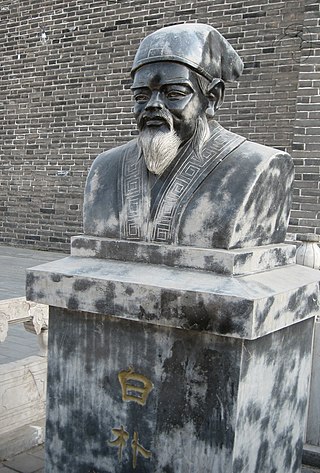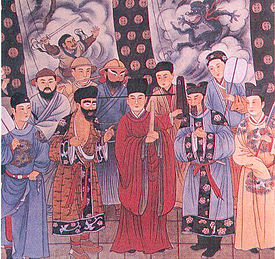
Throughout Chinese history, "Emperor" was the superlative title held by the monarchs who ruled various imperial dynasties. In traditional Chinese political theory, the emperor was the "Son of Heaven", an autocrat with the divine mandate right to rule all under Heaven. Emperors were worshiped posthumously under an imperial cult. The lineage of emperors descended from a paternal family line constituted a dynasty, and succession in most cases theoretically followed agnatic primogeniture.
The history of literature is the historical development of writings in prose or poetry that attempt to provide entertainment or education to the reader, as well as the development of the literary techniques used in the communication of these pieces. Not all writings constitute literature. Some recorded materials, such as compilations of data are not considered literature, and this article relates only to the evolution of the works defined above.

Chinese poetry is poetry written, spoken, or chanted in the Chinese language, and a part of the Chinese literature. While this last term comprises Classical Chinese, Standard Chinese, Mandarin Chinese, Yue Chinese, and other historical and vernacular forms of the language, its poetry generally falls into one of two primary types, Classical Chinese poetry and Modern Chinese poetry.

Classical Chinese poetry is traditional Chinese poetry written in Classical Chinese and typified by certain traditional forms, or modes; traditional genres; and connections with particular historical periods, such as the poetry of the Tang dynasty. The existence of classical Chinese poetry is documented at least as early as the publication of the Classic of Poetry (Shijing). Various combinations of forms and genres have developed over the ages. Many or most of these poetic forms were developed by the end of the Tang dynasty, in 907 CE.

Chinese Opera is a form of theatre in China that combines singing, acting, and elaborate costumes. Topics are based on Chinese history, mythology, and literature. Over its historical evolution, it has incorporated various art forms such as music, song and dance, martial arts, acrobatics, costume and make-up art, and literature. It has highly formalized roles, performed by professional actors each trained for specific roles. Exaggerated features and colors make the roles easily identifiable.

Kunqu, also known as Kunju (崑劇), K'un-ch'ü, Kun opera or Kunqu Opera, is one of the oldest extant forms of Chinese opera. It evolved from a music style local to Kunshan, part of the Wu cultural area, and later came to dominate Chinese theater from the 16th to the 18th centuries. It has been listed as one of the Masterpieces of the Oral and Intangible Heritage of Humanity by UNESCO. Wei Liangfu refined the musical style of kunqu, and it gained widespread popularity when Liang Chenyu used the style in his drama Huansha ji. In 2006, it was listed on the first national intangible cultural heritage list. In 2008, it was included in the List of Representative Works of Intangible Cultural Heritage of Humanity. In December 2018, the General Office of the Ministry of Education announced that Peking University is the base for inheriting excellent traditional Chinese culture in Kunqu.

Classic Chinese Novels are the best-known novels of pre-modern Chinese literature. These are among the world's longest and oldest novels. They represented a new complexity in structure and sophistication in language that helped to establish the novel as a respected form among later popular audiences and erudite critics.

Bai Renfu, also known as Bai Pu, was a renowned Chinese playwright of the Yuan dynasty.

Theatre of China has a long and complex history. Traditional Chinese theatre, generally in the form of Chinese opera, is musical in nature. Chinese theatre can trace its origin back a few millennia to ancient China, but the Chinese opera started to develop in the 12th century. Western forms like the spoken drama, western-style opera, and ballet did not arrive in China until the 20th century.
Sanqu is a fixed-rhythm form of Classical Chinese poetry or "literary song". Specifically sanqu is a subtype of the qu formal type of poetry. Sanqu was a notable Chinese poetic form, possibly beginning in the Jin dynasty (1115–1234), but especially associated with the Yuan (1271–1368), Ming (1368–1644) and Qing (1644–1912) dynasties. The tonal patterns modeled on tunes drawn from folk songs or other music.

The arts of China have varied throughout its ancient history, divided into periods by the ruling dynasties of China and changing technology, but still containing a high degree of continuity. Different forms of art have been influenced by great philosophers, teachers, religious figures and even political leaders. The arrival of Buddhism and modern Western influence produced especially large changes. Chinese art encompasses fine arts, folk arts and performance arts.

The Yuan dynasty, officially the Great Yuan, was a Mongol-led imperial dynasty of China and a successor state to the Mongol Empire after its division. It was established by Kublai, the fifth khagan-emperor of the Mongol Empire from the Borjigin clan, and lasted from 1271 to 1368. In Chinese history, the Yuan dynasty followed the Song dynasty and preceded the Ming dynasty.
The Yuan dynasty (1271–1368) was a dynasty of China ruled by the Mongol Borjigin clan. Founded by Kublai Khan, it is considered one of the successors to the Mongol Empire.
Yuan poetry refers to those types or styles of poetry particularly associated with the era of the Yuan dynasty (1271–1368), in China. Although the poetic forms of past literature were continued, the Yuan period is particularly known for the development of the poetic aspects included in the complex mix of different art forms which characterize Chinese opera, namely the qu or fixed-tone pattern type of verses that were delivered by the actors of these shows. Although the language of Yuan poetry is still generally considered to be Classical Chinese, a certain vernacular aspect reflecting linguistic changes can be seen in some of the fixed-rhythm verse forms, such as Yuan ci and qu. Certain aspects of Yuan poetry can be understood in the context of the social and political changes which took place as part of the process of the Mongol conquest of the Jin and Song Dynasties and their subsequent establishment of the Yuan dynasty.

Qing poetry refers to the poetry of or typical of the Qing dynasty (1644–1911). Classical Chinese poetry continued to be the major poetic form of the Qing dynasty, during which the debates, trends and widespread literacy of the Ming period began to flourish once again after a transitional period during which the Qing dynasty had established its dominance. Also, popular versions of Classical Chinese poetry were transmitted through Qing dynasty anthologies, such as the collections of Tang poetry known as the Complete Tang Poems and the Three Hundred Tang Poems. The poetry of the Qing Dynasty has an ongoing and growing body of scholarly literature associated with its study. Both the poetry of the Ming dynasty and the poetry of the Qing dynasty are studied for poetry associated with Chinese opera, the developmental trends of Classical Chinese poetry and the transition to the more vernacular type of Modern Chinese poetry, as well as poetry by women in Chinese culture.
Sangluan refers to a genre of Classical Chinese poetry particularly associated with the era of the Yuan Dynasty (1271–1368), in China. Written in response to the tumultuous events leading up to and during the establishment of the Yuan Dynasty by Kublai Khan and the Mongol Empire. This genre of the poetry of the Yuan Dynasty focuses on the devastation of war and its associated death and destruction, specifically in terms of this historical process. According to one student of Yuan drama in this period, J. I. Crump:
Wilt L. Idema is a Dutch scholar and Sinologist who taught at University of Leiden and Harvard University (2000–13), presently emeritus at both universities. He specializes in Chinese literature, with interests in early Chinese drama, Chinese women's literature of the premodern period, Chinese popular narrative ballads, and early development of Chinese vernacular fiction.
Tian Yuan Tan is a Singaporean scholar of Chinese literature. Since 2019, he has served as Shaw Professor of Chinese at the University of Oxford and a Professorial Fellow of University College. Prior to his appointment at Oxford, he was Professor of Chinese Studies at SOAS, University of London.
The fashion in the Yuan dynasty of Mongol (1271–1368) showed cultural diversity with the coexistence of various ethnic clothing, such as Mongol clothing, Han clothing and Korean clothing. The Mongol dress was the clothing of elite for both genders. Mongol attire worn in the 13th-14th century was different from the Han clothing from the Tang and Song dynasties. The Yuan dynasty court clothing also allowed the mixed of Mongol and Han style, and the official dress code of the Yuan dynasty also became a mixture of Han and Mongol clothing styles. After the founding of the Yuan dynasty, the Mongols strongly influenced the lifestyle and customs of the Han people.
Hou Shuaqiao, also known as Qian Shuaqiao or possibly Qian Shuaxiao (欠耍削), was a Chinese acrobat and actor who played fujing roles in zaju performances. He was based in Khanbaliq (Dadu), the winter capital of the Yuan dynasty. He was best-known for his somersaults, a required skill for playing martial roles in traditional Chinese operas. His somersaults were the highest of all performers.













